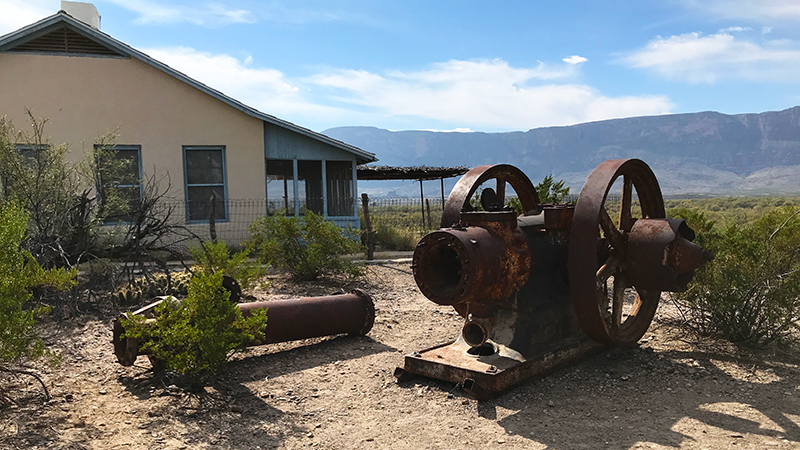
Castolon, also known as La Harmonia Ranch and Campo Santa Elena, was established in the early Twentieth Century and later served as the headquarters of the La Harmonia Company.
Castolon was first settled in 1901 by Cipriano Hernandez, who farmed the area and built the original Castolon Store, now known as the Alvino House.
During the Mexican Revolution of 1910, the area attracted refugees from Mexico. In 1916, a U.S. Army encampment, called Campo Santa Helena, was built to house units patrolling the border. It was completed in 1920, but by then political stability had returned to Mexico, the border was quiet, and the Army withdrew their presence without ever using the buildings.
In 1921, Wayne Cartledge moved into the army buildings and founded the La Harmonia Company in partnership with Howard Perry, owner of the Chisos Mining Company in Terlingua. La Harmonia operated a trading post in the barracks building that served local families from both sides of the border, while they provided labor for Cartledge’s cotton farming operations.
In 1922, Cartledge was the first person to begin farming cotton along this part of the Rio Grande. He introduced steam and gas powered irrigation pumps to boost his harvests and eventually increased the value of his cotton by “ginning” it before he sold it — mechanically separating the seeds from the fibers.
By 1942, mounting costs and falling prices ended La Harmonia’s cotton venture and in 1961, it was sold to the National Park Service.
Today, the Big Bend National Park Castolon Visitor Center is located in the historic La Harmonia store building. Here you can:
- Pick up river use permits and pay entrance fees.
- Visit the Big Bend Natural History Association bookstore.
- Chat with a ranger and pick up a park map.
- Check out exhibits on the rich history of the area, including Santa Elena Canyon.
Next door to the Visitor Center is the La Harmonia Store that sells food, drinks, and snacks, gifts, souvenirs, apparel, and camp supplies. The picnic tables out front are semi-shaded and provide a great place to stop for lunch.
Scattered around the parking area are old farming machines and equipment and nearby is the quiet, riverside Cottonwood Campground.
Castolon Historic District
The Castolon Historic District provides a glimpse into Big Bend’s past through exhibits and historic adobe buildings. This historic site is divided into two areas:
- Old Castolon is made up of the Old Castolon Store, a cafe-residence, and a shed.
- The Army Compound includes a barracks building that is now the Castolon Store, a recreation hall, latrine, two officers’ residences, a granary, and tack room, as well as the Magdalena, Garlick, and Alvino residences.
As you drive from Castolon toward Santa Elena Canyon, you’ll pass crumbling adobe walls, cane and viga ceilings, and old stone fireplaces from other structures that were part of the Castolon community
Know Before You Go
About the Castolon Historic District:
- The Castolon Historic District, listed on the National Register of Historic Places, has a seasonal Visitor Center that is in the same building as the historic La Harmonia Store, which is open year round. Shaded picnic tables are available outside and there are historic adobe buildings, antique equipment, and historic exhibits.
- Castolon Visitor Center is located in the historic La Harmonia store building. It is open seasonally from November through April from 10:00 am to 4:00 pm. It is closed for lunch.
- There are clean, flush restrooms available.
- Inside each of Big Bend’s five visitor centers is a fully stocked bookstore operated in partnership with a private, non-profit organization called Big Bend Natural History Association (BBNHA). The bookstore carries educational books, videos, park information, and souvenirs. All profit from sales stays in the park.
About the Ross Maxwell Scenic Drive:
- The Ross Maxwell Scenic Drive is a 30 mile adventure through the Chihuahuan Desert landscape of Big Bend National Park to the banks of the Rio Grande.
- Ross Maxwell Drive is an out and back road that begins near the park’s Maverick Entrance and has many vista points, scenic pullouts, educational displays, and short hikes.
About Big Bend National Park:
- Big Bend National Park is located in Brewster County, southwest Texas.
- The name Big Bend refers to the great U-turn the Rio Grande makes in Southwest Texas. The Rio Grande defines the park’s southern boundary for 118 miles.
- Park entrances are open 24 hours daily, all year. Entrance fee stations have variable seasons and hours.
- Admission fees are valid for seven days and are $30/vehicle, $25/motorcycle, $15/individual/bicyclist/pedestrian.
- There are five Visitor Centers in Big Bend National Park: Panther Junction, Chisos Basin, Castolon, Persimmon Gap, and Rio Grande Village.
- Download the Big Bend National Park maps.
- There are three developed campgrounds in the park: the Chisos Basin, Rio Grande Village, and Cottonwood campgrounds. Sites are first come, first-served, although a limited number of campsites in Rio Grande Village and the Chisos Basin campgrounds are reservable.
- Convenience stores are available and open year-round at Rio Grande Village, the Chisos Basin, and in the historic La Harmonia store at Castolon.
- Gas stations are located at Panther Junction and Rio Grande Village, and outside the park in Study Butte and Stillwell’s Ranch. Diesel is available at Panther Junction and outside the park in Study Butte.
- Pets are not allowed on trails, off roads, or on the river. Your pet can only go where your car can go and must be on a leash no longer than six feet in length or in a cage at all times. Pet etiquette and park regulations require that you always clean up after your pet and dispose of waste in trash receptacles.










